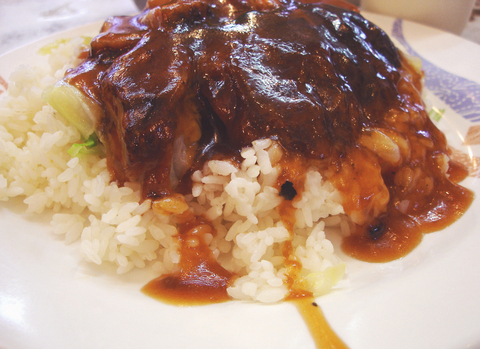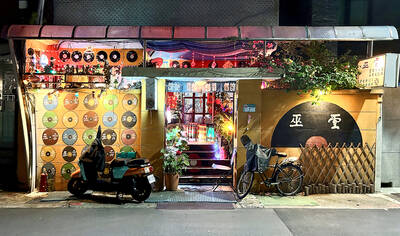More than one person has warned me away from eating at Feng Cheng, but nevertheless it's a popular hangout for lovers of Cantonese cuisine.
Across Xinsheng Road, from the side gate of NTU, Feng Cheng isn't big, but it's no hole in the wall, either, and the round family-sized tables filled up while I ate an early dinner there.
It's not hard to figure out why one might be wary of Feng Cheng: They do the dishes and cook the food in grungy-looking rooms in plain sight of the dining area, sausages hang on colored yarn against the plaster walls, and the green plastic dishes are kept in piles on the tables.

PHOTO: CHRIS PECHSTEDT, TAIPEI TIMES
As for the food, it tastes full of what to the palate are valuable oils, salts, and MSGs. One gets the feeling eating it that one's innermost organs are none too pleased.
And yet there is something worthwhile about this place. The food is appealing, in its own salty sort of way. There are Cantonese staples like shacha (沙茶) and he-fen (河粉) -- a tasty flat noodle you can get with most dishes -- and the barbequed pork (叉燒) and barbecued duck (燒鴨) are said to be famous.
The duck dish came with half an order of pork and at least one of the two meats was pretty good. The kitchen is definitely overzealous with the sauce, though.
One of the nice parts about Feng Cheng is that, even if the food is a bit much for some people, they aren't stingy with the vegetables or the fungi; the abundance of greens and mushrooms often successfully takes the edge off the salt.
Feng Cheng isn't good in the way of the fancy-schmancy NT$300-a-plate stuff we often review, but it does have a sort of guilty appeal similar to that of a greasy family-owned burger joint.
A warning to anyone squeamish around dead animals: The meat is stored in a glass booth that is visible from both the street and the dining area. It's not possible to avoid the sight of dozens of cooked but still very recognizable birds hanging by a single leg. If that sort of thing bothers you, steer clear.
It's certainly possible to find better food in Gongguan for the same price or less, so Feng Cheng is not necessarily the kind of place you'd want to do time on the MRT for, but if you're in the area and you're in the mood for something kind of salty and unhealthy you could do a lot worse -- assuming you aren't faint of stomach.

The Lee (李) family migrated to Taiwan in trickles many decades ago. Born in Myanmar, they are ethnically Chinese and their first language is Yunnanese, from China’s Yunnan Province. Today, they run a cozy little restaurant in Taipei’s student stomping ground, near National Taiwan University (NTU), serving up a daily pre-selected menu that pays homage to their blended Yunnan-Burmese heritage, where lemongrass and curry leaves sit beside century egg and pickled woodear mushrooms. Wu Yun (巫雲) is more akin to a family home that has set up tables and chairs and welcomed strangers to cozy up and share a meal

Dec. 8 to Dec. 14 Chang-Lee Te-ho (張李德和) had her father’s words etched into stone as her personal motto: “Even as a woman, you should master at least one art.” She went on to excel in seven — classical poetry, lyrical poetry, calligraphy, painting, music, chess and embroidery — and was also a respected educator, charity organizer and provincial assemblywoman. Among her many monikers was “Poetry Mother” (詩媽). While her father Lee Chao-yuan’s (李昭元) phrasing reflected the social norms of the 1890s, it was relatively progressive for the time. He personally taught Chang-Lee the Chinese classics until she entered public

Last week writer Wei Lingling (魏玲靈) unloaded a remarkably conventional pro-China column in the Wall Street Journal (“From Bush’s Rebuke to Trump’s Whisper: Navigating a Geopolitical Flashpoint,” Dec 2, 2025). Wei alleged that in a phone call, US President Donald Trump advised Japanese Prime Minister Sanae Takaichi not to provoke the People’s Republic of China (PRC) over Taiwan. Wei’s claim was categorically denied by Japanese government sources. Trump’s call to Takaichi, Wei said, was just like the moment in 2003 when former US president George Bush stood next to former Chinese premier Wen Jia-bao (溫家寶) and criticized former president Chen

President William Lai (賴清德) has proposed a NT$1.25 trillion (US$40 billion) special eight-year budget that intends to bolster Taiwan’s national defense, with a “T-Dome” plan to create “an unassailable Taiwan, safeguarded by innovation and technology” as its centerpiece. This is an interesting test for the Chinese Nationalist Party (KMT), and how they handle it will likely provide some answers as to where the party currently stands. Naturally, the Lai administration and his Democratic Progressive Party (DPP) are for it, as are the Americans. The Chinese Communist Party (CCP) is not. The interests and agendas of those three are clear, but